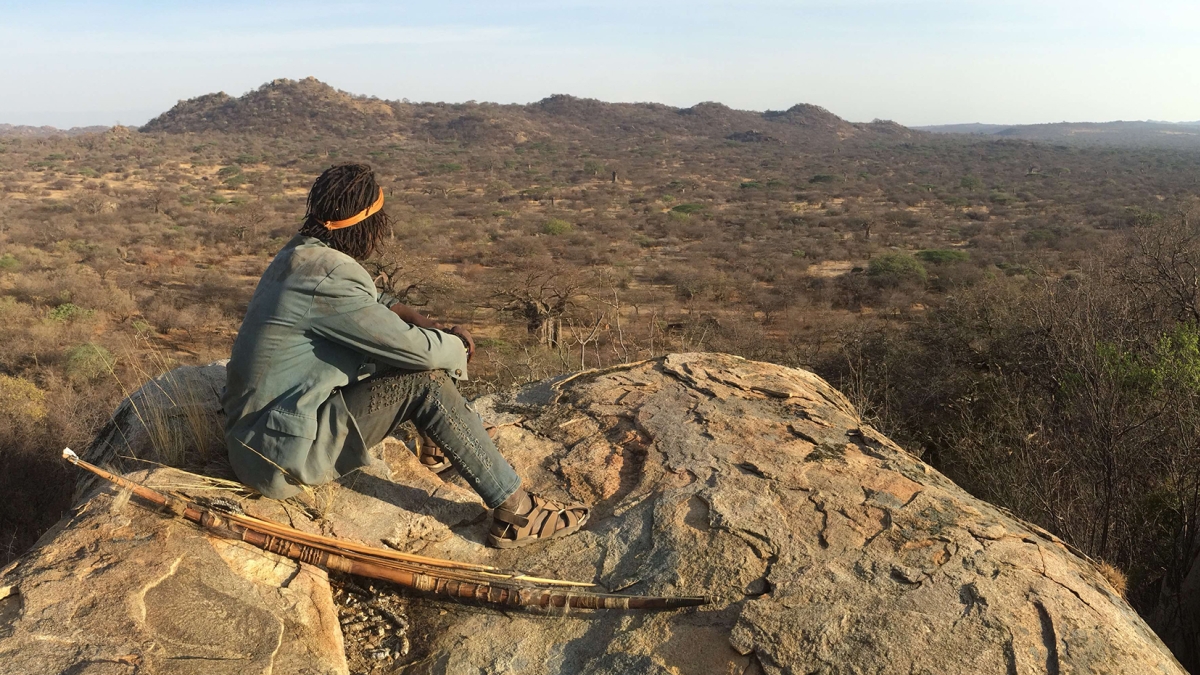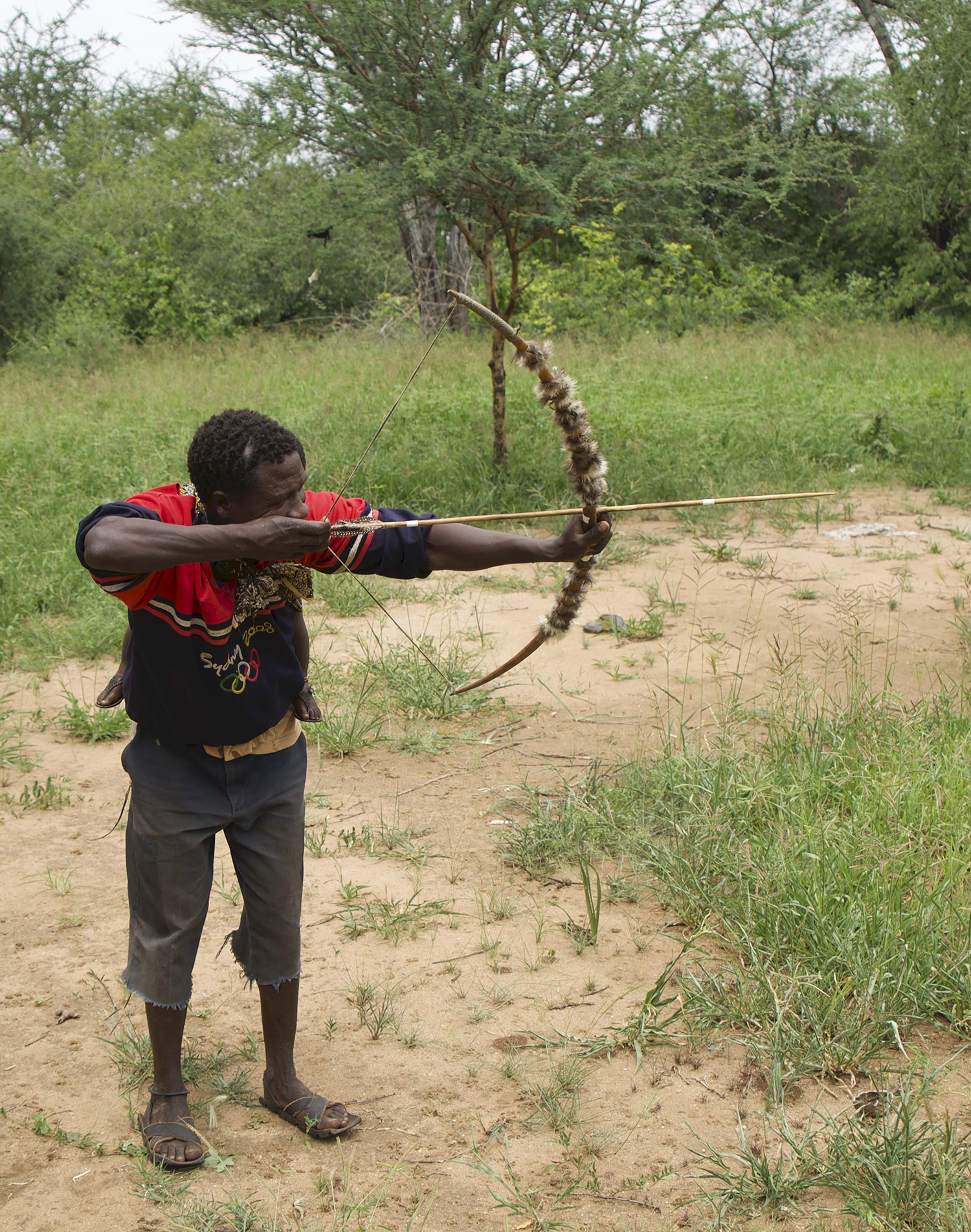Researchers take aim at the evolution of traditional technologies

Hadza hunter with bow. Image courtesy of Jacob Harris.
In the last 60,000 years, humans have emerged as an ecologically dominant species and have successfully colonized every terrestrial habitat. Our evolutionary success has been facilitated by a heavy reliance on an ever-advancing technology. Understanding how human technology evolves is crucial to understanding why humans have enjoyed such unprecedented evolutionary success.
Arizona State University doctoral graduate Jacob Harris, working with ASU researcher Robert Boyd and Brian Wood from the University of California, Los Angeles and the Max Planck Institute for Evolutionary Anthropology, is interested in the role of causal knowledge in the manufacture, transmission and, ultimately, the evolution of technology. Causal knowledge is the ability to predict the effect of an intentional modification of a system, like the design and manufacture of traditional bow-and-arrow technology — the focus of their investigation.
Prior research on causal knowledge has been restricted to theoretical work and experimental studies with student participants. Harris and Wood lived and worked with Hadza hunters for several months and interviewed them about bow manufacture and use. The Hadza are contemporary hunter-gathers who live in north-central Tanzania. There are currently around 1,200 speakers of the Hadza language distributed across a wide region, with local groups varying in the total fraction of their diet that is derived from hunting and gathering. However, even among those groups that forage the least, the manufacture and use of bow and arrow technology is a vibrant and daily practice among men.
The research, published this week in the journal Current Biology, addresses two competing theories in human evolution. The "cognitive niche" hypothesis proposes that innovations typically arise and are then refined over the course of a single lifetime, rather than generations, and if environments change people rapidly adapt. Proponents of this hypothesis argue that innovation and transmission require causal understanding. The "cultural niche" hypothesis holds that cultural elements often accumulate and recombine without a causal understanding by those who use them.
Hadza bowyers (bow makers) provide a rare opportunity to evaluate these models in a naturalistic setting involving one of the most significant technologies in human evolution — the bow and arrow.
Harris and Wood interviewed 64 highly skilled Hadza bowyers between the ages of 15 and 77 from five different camps regarding bow manufacture and use. Subjects were asked questions about their bows and asked to predict how minor modifications would affect either arrow speed or noise production. Queries included questions such as, “Will an increase in draw weight (strength of pull) result in the arrow traveling faster, slower or no change?” and “Will an increase in brace height — the distance from the bowstring to the inside of the bow — result in the arrow traveling faster, slower or no change?”

Hadza man with bow. Image courtesy of Jacob Harris.
“When making a bow, the bowyer confronts a series of complex trade-offs, and his design choices represent one possible solution out of a large number of possibilities,” Harris said. “The Hadza bow represents an elegant solution to an exceptionally complex optimization problem. Their bows are extremely versatile, capable of killing a wide range of prey and functioning in a variety of environments.” Harris conducted this research while a postdoctoral researcher at the University of California, Los Angeles.
The research findings suggest that the Hadza study participants are able to manufacture and transmit bow-making technology with only partial causal knowledge. It appears that some of the design choices made by Hadza bowyers are constrained by cultural norms rather than a desire to optimize performance. They also found that causal knowledge does not correlate with age. In other words, individuals don’t appear to acquire a more complete causal schema as they grow older.
“Hadza bowyers construct powerful bows from local materials and use them to hunt a wide variety of prey. Over 95% of Hadza men possess a bow, and hunters use their bows to provide the majority of the meat in their diet and therefore, represent a vital aspect of the Hadza economy,” Wood said. “Hadza men begin using bows at a very early age. Boys as young as 3 years old mimic the manufacturing behaviors of their elders and begin manufacturing their own bows. By early adulthood they are highly proficient bowyers and hunters.”
There is also no evidence that some individuals are significantly more knowledgeable than others. Prior research reported the presence of socially acknowledged “experts” in areas such as hunting, honey gathering and arrow making. However, bow-making skill, as perceived by Hadza bowyers, does not appear to be predicated on exceptional cause-and-effect knowledge of bow mechanics.
“The evolution of complex technologies, such as the bow, can occur with only partial causal understanding and has significant implications for our understanding of the cultural evolution of technology. It suggests that the human proclivity to rely upon cumulative culture rather than individual expertise likely has deep evolutionary roots,” said Boyd, professor in the School of Human Evolution and Social Change and research affiliate with the Institute of Human Origins.
“A more holistic understanding of technological evolution is necessary, one that does not view these two competing models as mutually exclusive. In our study, we found evidence to suggest that a complete causal understanding is not necessary, but we also identified key aspects of Hadza projectile technology that were more likely to be associated with causal knowledge,” Harris said.
The researchers will continue their investigation into which aspects of this technology are more likely to be associated with and without causal knowledge and explore the degree to which these are learned though experience and/or through direct (active teaching) or indirect (observation) transmission. Their research will contribute to the development of a more holistic theoretical model that accounts for the relative roles of multiple influences, including culture, causal knowledge and environmental constraints, such as resource availability.
This research was published as “The role of causal knowledge in the evolution of traditional technology,” in Current Biology, Jacob A. Harris, Robert Boyd, Brian M. Wood.
More Arts, humanities and education

ASU graduate education programs are again ranked among best
Arizona State University’s Mary Lou Fulton College for Teaching and Learning Innovation continues to be one of the best…
ASU FIDM students to see their designs on the runway at Uncertainty Fashion Showcase
Nola Hill is perfecting every stitch of her fashion design collection, which she started conceptualizing last summer.She is among…

ASU+GSV Summit brings experts together to discuss innovation in education
This week, Arizona State University President Michael Crow and other university leadership joined education and learning experts…

